Global Mangrove Watch: Updated 2010 Mangrove Forest Extent (v2.5)
Abstract
:1. Introduction
2. Materials and Methods
2.1. Areas to Be Mapped
2.2. Mangrove Habitat Mask
2.3. Mangrove Mapping
2.3.1. Sentinel-2 Processing
2.3.2. Building the Classification Models
2.3.3. Applying the Classification Models
2.4. Merging Mangrove Maps and Identify Change to 2010
2.5. Accuracy Assessment
3. Results
3.1. Remapped Regions Comparison
3.2. Overall Accuracy Assessment
3.3. Area Statistics
4. Discussion
4.1. Data and Methods
4.2. Future Baseline Mapping
5. Conclusions
Author Contributions
Funding
Institutional Review Board Statement
Informed Consent Statement
Data Availability Statement
Acknowledgments
Conflicts of Interest
Appendix A. National Mangrove Extent
| Country | GMW v2.5 (ha) 2010 | GMW 2.0 (ha) 2010 | Difference (ha) | Difference (%) |
|---|---|---|---|---|
| American Samoa | 33 | 19 | 14 | 74.8 |
| Angola | 28,969 | 37,346 | −8377 | −22.4 |
| Anguilla | 1 | 1 | 0 | −0.9 |
| Antigua and Barbuda | 863 | 889 | −25 | −2.9 |
| Aruba | 26 | 34 | −7 | −22.1 |
| Australia | 988,842 | 1,006,021 | −17,179 | −1.7 |
| Bahamas | 93,139 | 99,318 | −6179 | −6.2 |
| Bahrain | 59 | 82 | −23 | −28.4 |
| Bangladesh | 444,159 | 416,283 | 27,876 | 6.7 |
| Barbados | 14 | 14 | 0 | −1.8 |
| Belize | 44,507 | 44,784 | −277 | −0.6 |
| Benin | 3390 | 84 | 3307 | 3957.0 |
| Bermuda | 8 | 0 | 8 | − |
| Bonaire, Sint Eustatius and Saba | 165 | 166 | −2 | −1.0 |
| Brazil | 1,081,106 | 1,107,207 | −26,101 | −2.4 |
| British Virgin Islands | 83 | 90 | −7 | −7.7 |
| Brunei | 11,491 | 11,163 | 328 | 2.9 |
| Cambodia | 58,517 | 59,230 | −714 | −1.2 |
| Cameroon | 199,109 | 191,326 | 7783 | 4.1 |
| Cayman Islands | 4148 | 4199 | −50 | −1.2 |
| China | 14,221 | 15,084 | −863 | −5.7 |
| Colombia | 262,212 | 231,187 | 31,025 | 13.4 |
| Comoros | 99 | 103 | −3 | −3.2 |
| Cook Islands | 3 | 0 | 3 | − |
| Costa Rica | 36,475 | 36,872 | −397 | −1.1 |
| Côte d’Ivoire | 5890 | 6131 | −241 | −3.9 |
| Cuba | 332,816 | 337,113 | −4297 | −1.3 |
| Curaçao | 7 | 7 | 0 | −1.2 |
| Democratic Republic of the Congo | 24,017 | 25,810 | −1793 | −6.9 |
| Djibouti | 545 | 498 | 47 | 9.4 |
| Dominica | 2 | 2 | 0 | −9.9 |
| Dominican Republic | 18,741 | 18,942 | −201 | −1.1 |
| Ecuador | 146,544 | 139,416 | 7128 | 5.1 |
| Egypt | 147 | 180 | −33 | −18.2 |
| El Salvador | 37,589 | 37,665 | −76 | −0.2 |
| Equatorial Guinea | 25,904 | 25,984 | −80 | −0.3 |
| Eritrea | 6918 | 7006 | −88 | −1.3 |
| Fiji | 49,984 | 51,166 | −1182 | −2.3 |
| French Guiana | 59,466 | 50,187 | 9279 | 18.5 |
| French Polynesia | 122 | 0 | 122 | − |
| French Southern Territories | 672 | 0 | 672 | − |
| Gabon | 176,632 | 177,091 | −458 | −0.3 |
| Gambia | 60,673 | 61,294 | −621 | −1.0 |
| Ghana | 20,021 | 20,557 | −536 | −2.6 |
| Grenada | 190 | 195 | −5 | −2.7 |
| Guadeloupe | 3713 | 3735 | −22 | −0.6 |
| Guam | 57 | 0 | 57 | − |
| Guatemala | 23,523 | 23,709 | −187 | −0.8 |
| Guinea | 222,286 | 223,849 | −1562 | −0.7 |
| Guinea−Bissau | 262,631 | 262,616 | 15 | 0.0 |
| Guyana | 28,640 | 27,472 | 1168 | 4.3 |
| Haiti | 14,432 | 14,635 | −203 | −1.4 |
| Honduras | 59,732 | 60,372 | −640 | −1.1 |
| India | 370,984 | 352,052 | 18,933 | 5.4 |
| Indonesia | 2,801,795 | 2,688,955 | 112,840 | 4.2 |
| Iran | 7587 | 7912 | −325 | −4.1 |
| Jamaica | 9411 | 9520 | −109 | −1.1 |
| Japan | 918 | 987 | −69 | −7.0 |
| Kenya | 52,888 | 53,788 | −900 | −1.7 |
| Kiribati | 135 | 0 | 135 | − |
| Liberia | 18,938 | 19,153 | −215 | −1.1 |
| Madagascar | 260,271 | 260,986 | −715 | −0.3 |
| Malaysia | 515,743 | 520,071 | −4329 | −0.8 |
| Maldives | 97 | 0 | 97 | − |
| Marshall Islands | 6 | 0 | 6 | − |
| Martinique | 2052 | 1700 | 352 | 20.7 |
| Mauritania | 177 | 104 | 73 | 70.4 |
| Mauritius | 345 | 703 | −357 | −50.9 |
| Mayotte | 702 | 589 | 113 | 19.2 |
| Mexico | 939,502 | 953,651 | −14,150 | −1.5 |
| Micronesia | 9084 | 8399 | 685 | 8.2 |
| Mozambique | 298,841 | 301,125 | −2284 | −0.8 |
| Myanmar | 496,686 | 501,116 | −4430 | −0.9 |
| New Caledonia | 33,593 | 29,625 | 3967 | 13.4 |
| New Zealand | 30,216 | 30,627 | −411 | −1.3 |
| Nicaragua | 73,988 | 74,988 | −1000 | −1.3 |
| Nigeria | 847,894 | 695,775 | 152,119 | 21.9 |
| Oman | 111 | 116 | −5 | −4.3 |
| Pakistan | 63,600 | 65,240 | −1641 | −2.5 |
| Palau | 6014 | 6183 | −169 | −2.7 |
| Panama | 153,337 | 154,477 | −1140 | −0.7 |
| Papua New Guinea | 445,785 | 476,167 | −30,382 | −6.4 |
| Peru | 4569 | 4083 | 486 | 11.9 |
| Philippines | 260,993 | 265,108 | −4115 | −1.6 |
| Puerto Rico | 8685 | 8869 | −184 | −2.1 |
| Qatar | 428 | 444 | −16 | −3.6 |
| Republic of Congo | 2063 | 0 | 2063 | − |
| Saint Kitts and Nevis | 28 | 29 | −1 | −3.0 |
| Saint Lucia | 164 | 166 | −2 | −1.1 |
| Saint Vincent and the Grenadines | 31 | 33 | −2 | −5.5 |
| Saint−Martin | 14 | 15 | 0 | −3.0 |
| Samoa | 264 | 305 | −40 | −13.3 |
| São Tomé and Príncipe | 0 | 0 | 0 | 12.0 |
| Saudi Arabia | 5367 | 6824 | −1457 | −21.4 |
| Senegal | 128,077 | 128,934 | −856 | −0.7 |
| Seychelles | 385 | 107 | 277 | 258.2 |
| Sierra Leone | 160,038 | 127,759 | 32,279 | 25.3 |
| Singapore | 534 | 540 | −6 | −1.2 |
| Solomon Islands | 55,519 | 51,424 | 4094 | 8.0 |
| Somalia | 2253 | 2098 | 154 | 7.4 |
| South Africa | 2573 | 2637 | −64 | −2.4 |
| Sri Lanka | 18,941 | 20,164 | −1223 | −6.1 |
| Sudan | 433 | 366 | 67 | 18.2 |
| Suriname | 77,108 | 78,154 | −1046 | −1.3 |
| Taiwan | 159 | 171 | −12 | −7.0 |
| Tanzania | 107,775 | 113,101 | −5326 | −4.7 |
| Thailand | 223,137 | 225,770 | −2634 | −1.2 |
| Timor−Leste | 957 | 983 | −26 | −2.7 |
| Togo | 21 | 0 | 21 | − |
| Tonga | 1193 | 872 | 321 | 36.8 |
| Trinidad and Tobago | 7696 | 5523 | 2173 | 39.3 |
| Turks and Caicos Islands | 10,420 | 12,260 | −1840 | −15.0 |
| Tuvalu | 9 | 0 | 9 | − |
| United Arab Emirates | 6759 | 7766 | −1008 | −13.0 |
| United States | 209,544 | 193,609 | 15,935 | 8.2 |
| Vanuatu | 1724 | 1782 | −58 | −3.2 |
| Venezuela | 275,325 | 287,130 | −11,805 | −4.1 |
| Vietnam | 157,028 | 159,952 | −2924 | −1.8 |
| Virgin Islands, U.S. | 197 | 206 | −8 | −4.1 |
| Wallis and Futuna | 29 | 0 | 29 | − |
| Yemen | 1314 | 1753 | −439 | −25.0 |
| Global | 14,025,986 | 13,760,074 | 265,912 | 1.9 |
References
- Hamilton, S.E.; Casey, D. Creation of a high spatio-temporal resolution global database of continuous mangrove forest cover for the 21st century (CGMFC-21). Glob. Ecol. Biogeogr. 2016, 25, 729–738. [Google Scholar] [CrossRef]
- Goldberg, L.; Lagomasino, D.; Thomas, N.; Fatoyinbo, T. Global declines in human-driven mangrove loss. Glob. Chang. Biol. 2020, 26, 5844–5855. [Google Scholar] [CrossRef] [PubMed]
- Thomas, N.; Lucas, R.; Bunting, P.; Hardy, A.; Rosenqvist, A.; Simard, M. Distribution and drivers of global mangrove forest change, 1996–2010. PLoS ONE 2017, 12, e0179302. [Google Scholar] [CrossRef] [PubMed] [Green Version]
- Lacerda, L.D.D.; Ward, R.D.; Godoy, M.D.P.; Meireles, A.J.D.A.; Borges, R.; Ferreira, A.C. 20-Years Cumulative Impact From Shrimp Farming on Mangroves of Northeast Brazil. Front. For. Glob. Chang. 2021, 4, 653096. [Google Scholar] [CrossRef]
- Giri, C.; Zhu, Z.; Tieszen, L.L.; Singh, A.; Gillette, S.; Kelmelis, J.A. Mangrove forest distributions and dynamics (1975–2005) of the tsunami-affected region of Asia. J. Biogeogr. 2008, 35, 519–528. [Google Scholar] [CrossRef]
- Ai, B.; Ma, C.; Zhao, J.; Zhang, R. The impact of rapid urban expansion on coastal mangroves: A case study in Guangdong Province, China. Front. Earth Sci. 2020, 14, 37–49. [Google Scholar] [CrossRef]
- Richards, D.R.; Friess, D.A. Rates and drivers of mangrove deforestation in Southeast Asia, 2000–2012. Proc. Natl. Acad. Sci. USA 2016, 113, 344–349. [Google Scholar] [CrossRef] [Green Version]
- Duke, N.C.; Kovacs, J.M.; Griffiths, A.D.; Preece, L.; Hill, D.J.; Van Oosterzee, P.; Mackenzie, J.; Morning, H.S.; Burrows, D. Large-scale dieback of mangroves in Australia’s Gulf of Carpentaria: A severe ecosystem response, coincidental with an unusually extreme weather event. Mar. Freshw. Res. 2017, 68, 1816–1829. [Google Scholar] [CrossRef]
- Ermgassen, P.S.Z.; Mukherjee, N.; Worthington, T.A.; Acosta, A.; Araujo, A.R.d.R.; Beitl, C.M.; Castellanos-Galindo, G.A.; Cunha-Lignon, M.; Dahdouh-Guebas, F.; Diele, K.; et al. Fishers who rely on mangroves: Modelling and mapping the global intensity of mangrove-associated fisheries. Estuar. Coast. Shelf Sci. 2020, 247, 106975. [Google Scholar] [CrossRef]
- Donato, D.C.; Kauffman, J.B.; Murdiyarso, D.; Kurnianto, S.; Stidham, M.; Kanninen, M. Mangroves among the most carbon-rich forests in the tropics. Nat. Geosci. 2011, 4, 293–297. [Google Scholar] [CrossRef]
- Menéndez, P.; Losada, I.J.; Torres-Ortega, S.; Narayan, S.; Beck, M.W. The Global Flood Protection Benefits of Mangroves. Sci. Rep. 2020, 10, 4404. [Google Scholar] [CrossRef] [PubMed]
- Spalding, M.; Parrett, C.L. Global patterns in mangrove recreation and tourism. Mar. Policy 2019, 110, 103540. [Google Scholar] [CrossRef]
- Costanza, R.; Groot, R.d.; Sutton, P.; Ploeg, S.v.d.; Anderson, S.J.; Kubiszewski, I.; Farber, S.; Turner, R.K. Changes in the global value of ecosystem services. Glob. Environ. Chang. 2014, 26, 152–158. [Google Scholar] [CrossRef]
- Simard, M.; Fatoyinbo, L.; Smetanka, C.; Rivera-Monroy, V.H.; Castañeda-Moya, E.; Thomas, N.; Stocken, T.V.d. Mangrove canopy height globally related to precipitation, temperature and cyclone frequency. Nat. Geosci. 2019, 12, 40–45. [Google Scholar] [CrossRef]
- Bunting, P.; Rosenqvist, A.; Lucas, R.; Rebelo, L.M.; Hilarides, L.; Thomas, N.; Hardy, A.; Itoh, T.; Shimada, M.; Finlayson, C. The Global Mangrove Watch—A New 2010 Global Baseline of Mangrove Extent. Remote Sens. 2018, 10, 1669. [Google Scholar] [CrossRef] [Green Version]
- Bunting, P.; Rosenqvist, A.; Lucas, R.; Rebelo, L.M.; Hilarides, L.; Thomas, N.; Hardy, A.; Itoh, T.; Shimada, M.; Finlayson, M. Global Mangrove Watch (1996–2016) Version 2.0; Zenodo: Genève, Switzerland, 2019. [Google Scholar] [CrossRef]
- Giri, C.; Ochieng, E.; Tieszen, L.L.; Zhu, Z.; Singh, A.; Loveland, T.; Masek, J.; Duke, N. Status and distribution of mangrove forests of the world using earth observation satellite data. Glob. Ecol. Biogeogr. 2011, 20, 154–159. [Google Scholar] [CrossRef]
- Spalding, M. World Atlas of Mangroves; Routledge: London, UK, 2010. [Google Scholar] [CrossRef]
- Thomas, N.; Lucas, R.; Itoh, T.; Simard, M.; Fatoyinbo, L.; Bunting, P.; Rosenqvist, A. An approach to monitoring mangrove extents through time-series comparison of JERS-1 SAR and ALOS PALSAR data. Wetl. Ecol. Manag. 2014, 23, 3–17. [Google Scholar] [CrossRef]
- Thomas, N.; Bunting, P.; Lucas, R.; Hardy, A.; Rosenqvist, A.; Fatoyinbo, T. Mapping Mangrove Extent and Change: A Globally Applicable Approach. Remote Sens. 2018, 10, 1466. [Google Scholar] [CrossRef] [Green Version]
- Baloloy, A.B.; Blanco, A.C.; Ana, R.R.C.S.; Nadaoka, K. Development and application of a new mangrove vegetation index (MVI) for rapid and accurate mangrove mapping. ISPRS J. Photogramm. Remote Sens. 2020, 166, 95–117. [Google Scholar] [CrossRef]
- Li, H.; Han, Y.; Chen, J. Combination of Google Earth imagery and Sentinel-2 data for mangrove species mapping. J. Appl. Remote Sens. 2020, 14, 010501. [Google Scholar] [CrossRef]
- Ghorbanian, A.; Zaghian, S.; Asiyabi, R.M.; Amani, M.; Mohammadzadeh, A.; Jamali, S. Mangrove Ecosystem Mapping Using Sentinel-1 and Sentinel-2 Satellite Images and Random Forest Algorithm in Google Earth Engine. Remote Sens. 2021, 13, 2565. [Google Scholar] [CrossRef]
- Cissell, J.R.; Canty, S.W.J.; Steinberg, M.K.; Simpson, L.T. Mapping National Mangrove Cover for Belize Using Google Earth Engine and Sentinel-2 Imagery. Appl. Sci. 2021, 11, 4258. [Google Scholar] [CrossRef]
- Liu, X.; Fatoyinbo, T.E.; Thomas, N.M.; Guan, W.W.; Zhan, Y.; Mondal, P.; Lagomasino, D.; Simard, M.; Trettin, C.C.; Deo, R.; et al. Large-Scale High-Resolution Coastal Mangrove Forests Mapping Across West Africa With Machine Learning Ensemble and Satellite Big Data. Front. Earth Sci. 2021, 8, 560933. [Google Scholar] [CrossRef]
- Awty-Carroll, K.; Bunting, P.; Hardy, A.; Bell, G. Using Continuous Change Detection and Classification of Landsat Data to Investigate Long-Term Mangrove Dynamics in the Sundarbans Region. Remote Sens. 2019, 11, 2833. [Google Scholar] [CrossRef] [Green Version]
- Awty-Carroll, K.; Bunting, P.; Hardy, A.; Bell, G. Evaluation of the Continuous Monitoring of Land Disturbance Algorithm for Large-Scale Mangrove Classification. Remote Sens. 2021, 13, 3978. [Google Scholar] [CrossRef]
- Zhu, Z.; Zhang, J.; Yang, Z.; Aljaddani, A.H.; Cohen, W.B.; Qiu, S.; Zhou, C. Continuous monitoring of land disturbance based on Landsat time series. Remote Sens. Environ. 2019, 238, 111116. [Google Scholar] [CrossRef]
- Bunting, P.; Clewley, D.; Lucas, R.M.; Gillingham, S. The Remote Sensing and GIS Software Library (RSGISLib). Comput. Geosci. 2014, 62, 216–226. [Google Scholar] [CrossRef]
- Bunting, P.; Gillingham, S. The KEA image file format. Comput. Geosci. 2013, 57, 54–58. [Google Scholar] [CrossRef]
- Available online: https://www.remotesensing.info/pbprocesstools/ (accessed on 8 January 2022).
- Chen, T.; Guestrin, C. XGBoost: A Scalable Tree Boosting System. In Proceedings of the 22nd ACM SIGKDD International Conference on Knowledge Discovery and Data Mining, San Francisco, CA, USA, 13–17 August 2016; pp. 785–794. [Google Scholar] [CrossRef] [Green Version]
- Available online: https://cloud.google.com/storage/docs/public-datasets/sentinel-2 (accessed on 8 January 2022).
- Available online: https://www.remotesensing.info/arcsi/ (accessed on 8 January 2022).
- John, E.; Bunting, P.; Hardy, A.; Silayo, D.S.; Masunga, E. A Forest Monitoring System for Tanzania. Remote Sens. 2021, 13, 3081. [Google Scholar] [CrossRef]
- Vermote, E.; Tanre, D.; Deuze, J.; Herman, M.; Morcrette, J. Second Simulation of the Satellite Signal in the Solar Spectrum, 6S: An overview. IEEE Trans. Geosci. Remote Sens. 1997, 35, 675–686. [Google Scholar] [CrossRef] [Green Version]
- Wilson, R.T. Py6S: A Python interface to the 6S radiative transfer model. Comput. Geosci. 2013, 51, 166–171. [Google Scholar] [CrossRef] [Green Version]
- Shepherd, J.D.; Dymond, J.R. Correcting satellite imagery for the variance of reflectance and illumination with topography. Int. J. Remote Sens. 2003, 24, 3503–3514. [Google Scholar] [CrossRef]
- Zhu, Z.; Woodcock, C.E.; Olofsson, P. Continuous monitoring of forest disturbance using all available Landsat imagery. Remote Sens. Environ. 2012, 122, 75–91. [Google Scholar] [CrossRef]
- Zhu, Z.; Wang, S.; Woodcock, C.E. Improvement and expansion of the Fmask algorithm: Cloud, cloud shadow, and snow detection for Landsats 4–7, 8, and Sentinel 2 images. Remote Sens. Environ. 2015, 159, 269–277. [Google Scholar] [CrossRef]
- Available online: http://www.pythonfmask.org (accessed on 8 January 2022).
- Available online: https://github.com/sentinel-hub/sentinel2-cloud-detector (accessed on 8 January 2022).
- Ke, G.; Meng, Q.; Finley, T.; Wang, T.; Chen, W.; Ma, W.; Ye, Q.; Liu, T.Y. LightGBM: A Highly Efficient Gradient Boosting Decision Tree. In Proceedings of the 31st Conference on Neural Information Processing Systems (NIPS 2017), Long Beach, CA, USA, 4–9 December 2017. [Google Scholar]
- Reseau National D’observation et D’aide a la Gestion des Mangroves. Les Surfaces de Mangroves an France en 2020. Available online: https://uicn.fr/wp-content/uploads/2017/07/plaquette-rom-060717.pdf (accessed on 8 January 2022).
- Pekel, J.F.; Cottam, A.; Gorelick, N.; Belward, A.S. High-resolution mapping of global surface water and its long-term changes. Nature 2016, 540, 418–422. [Google Scholar] [CrossRef]

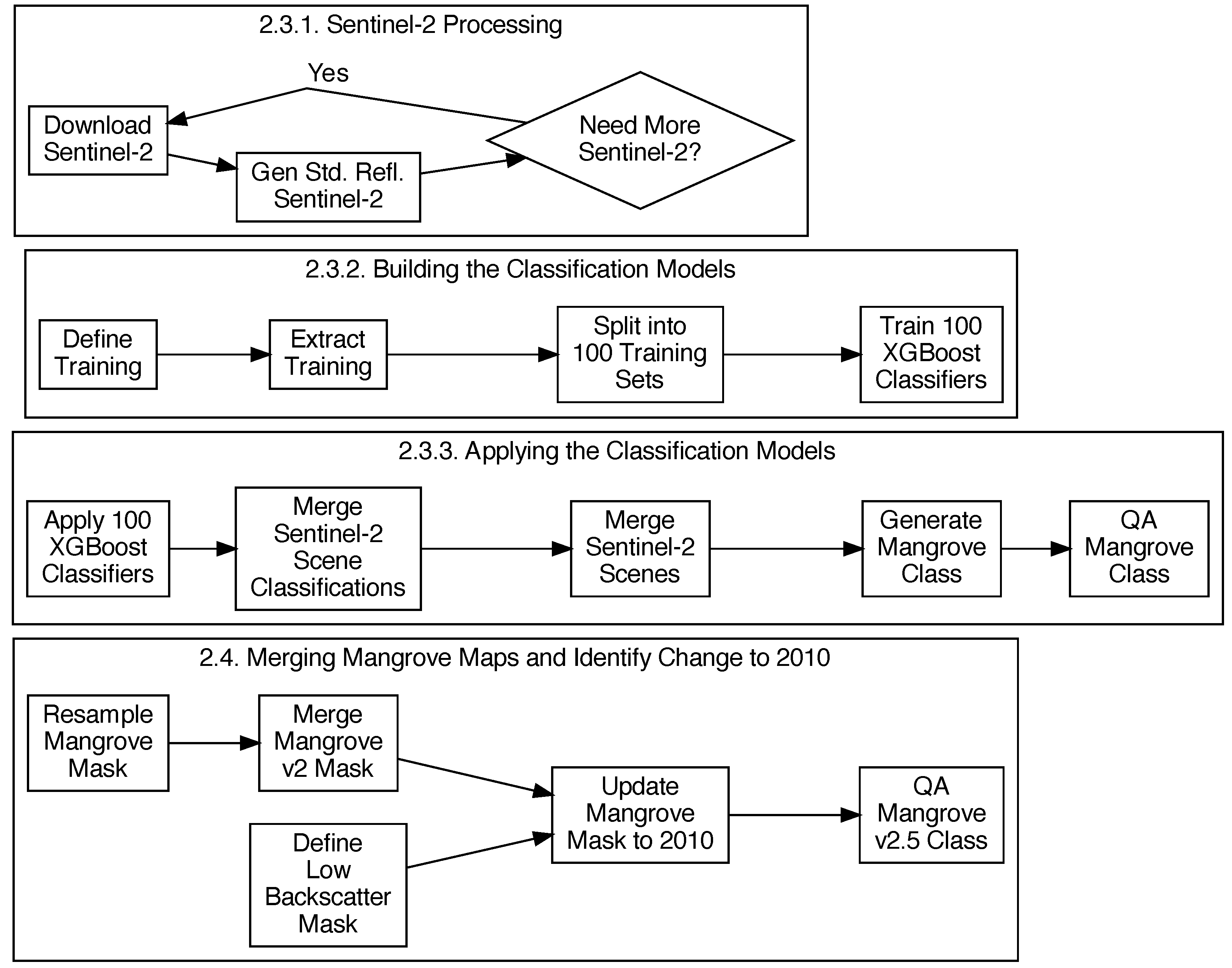


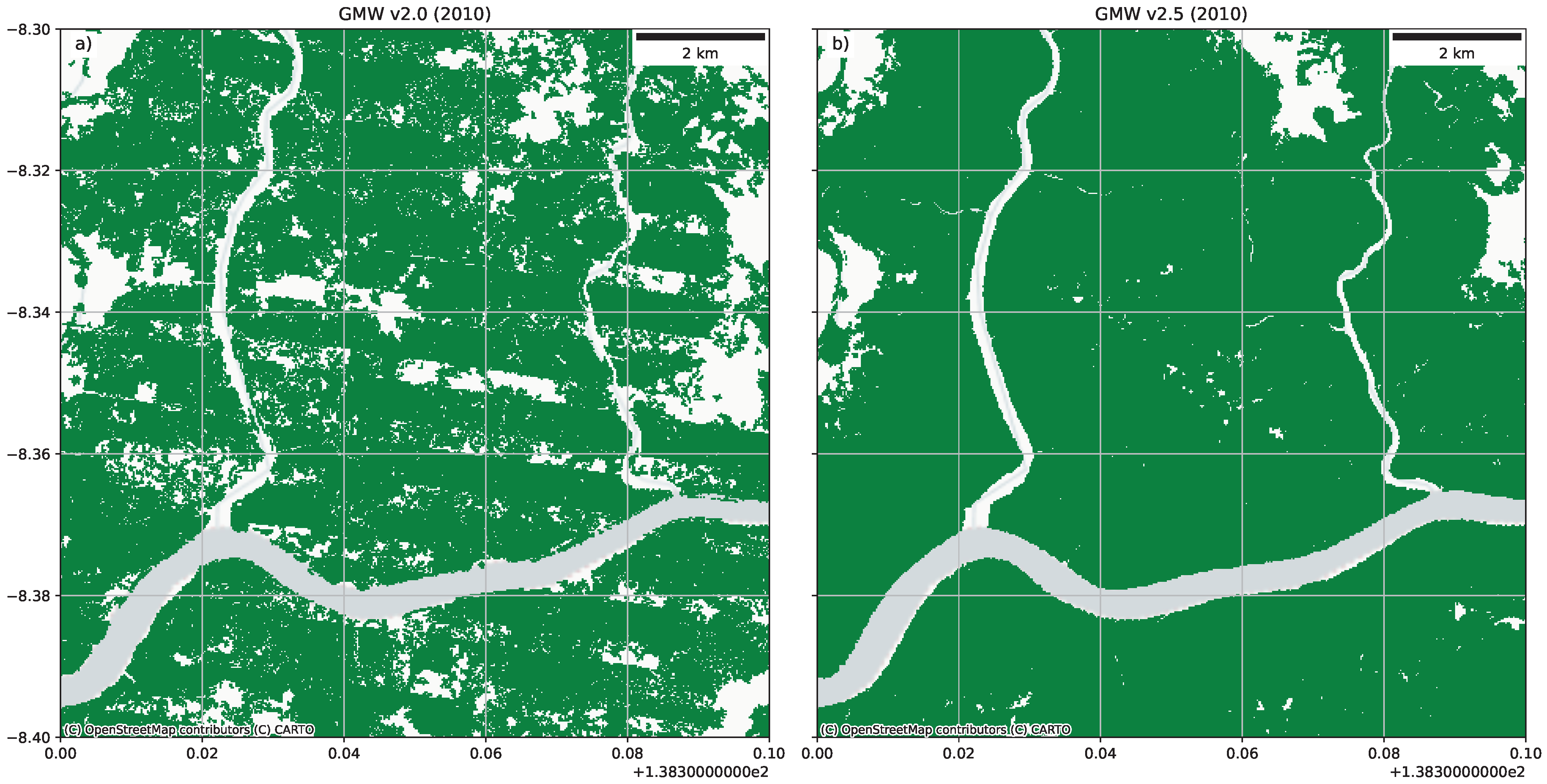
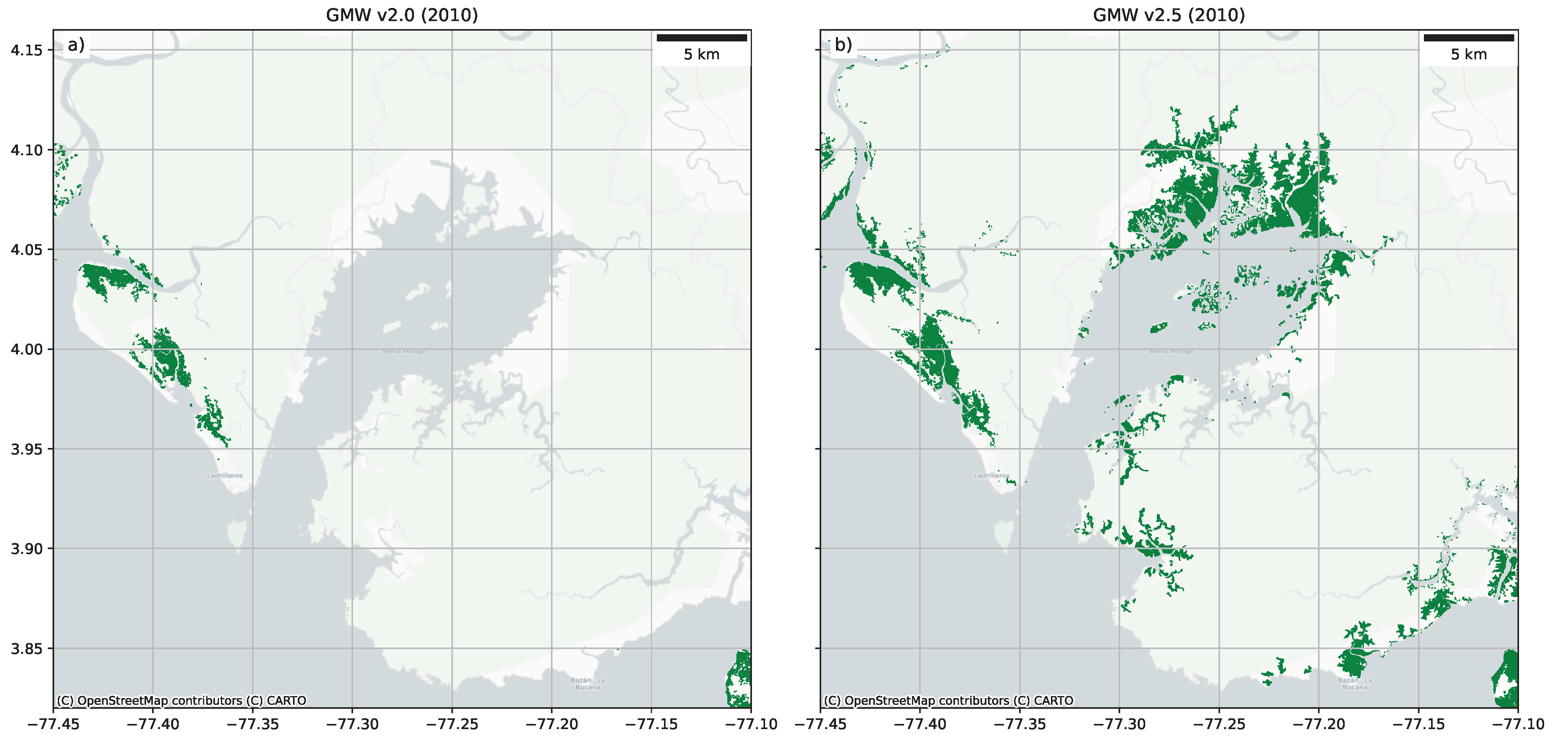
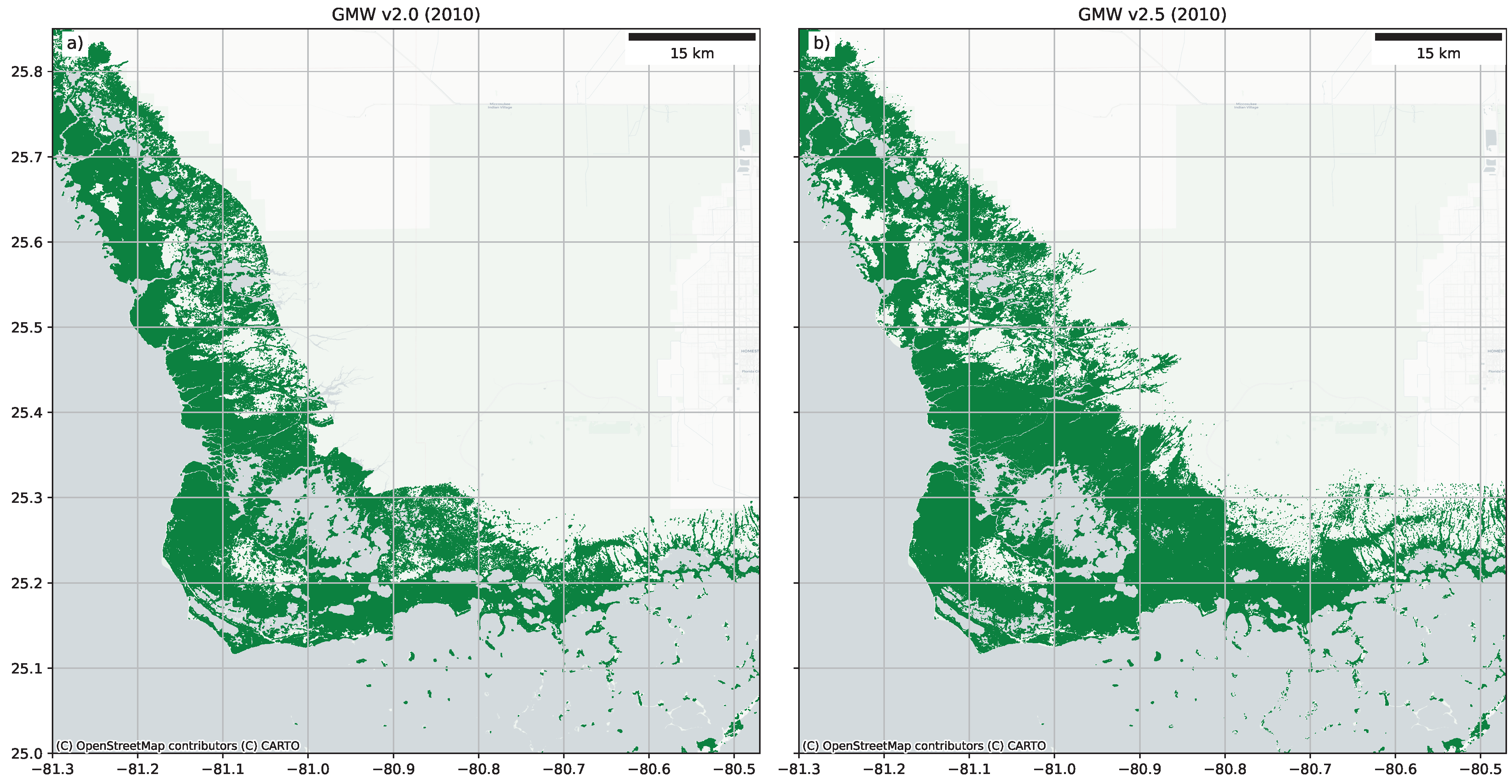
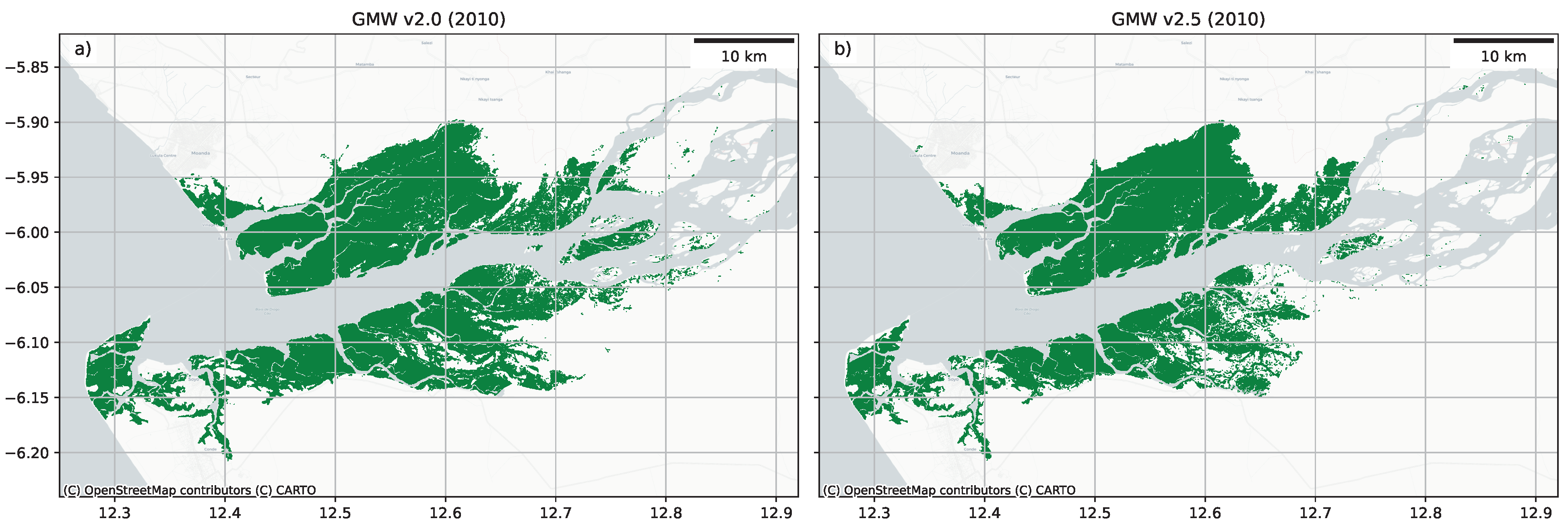
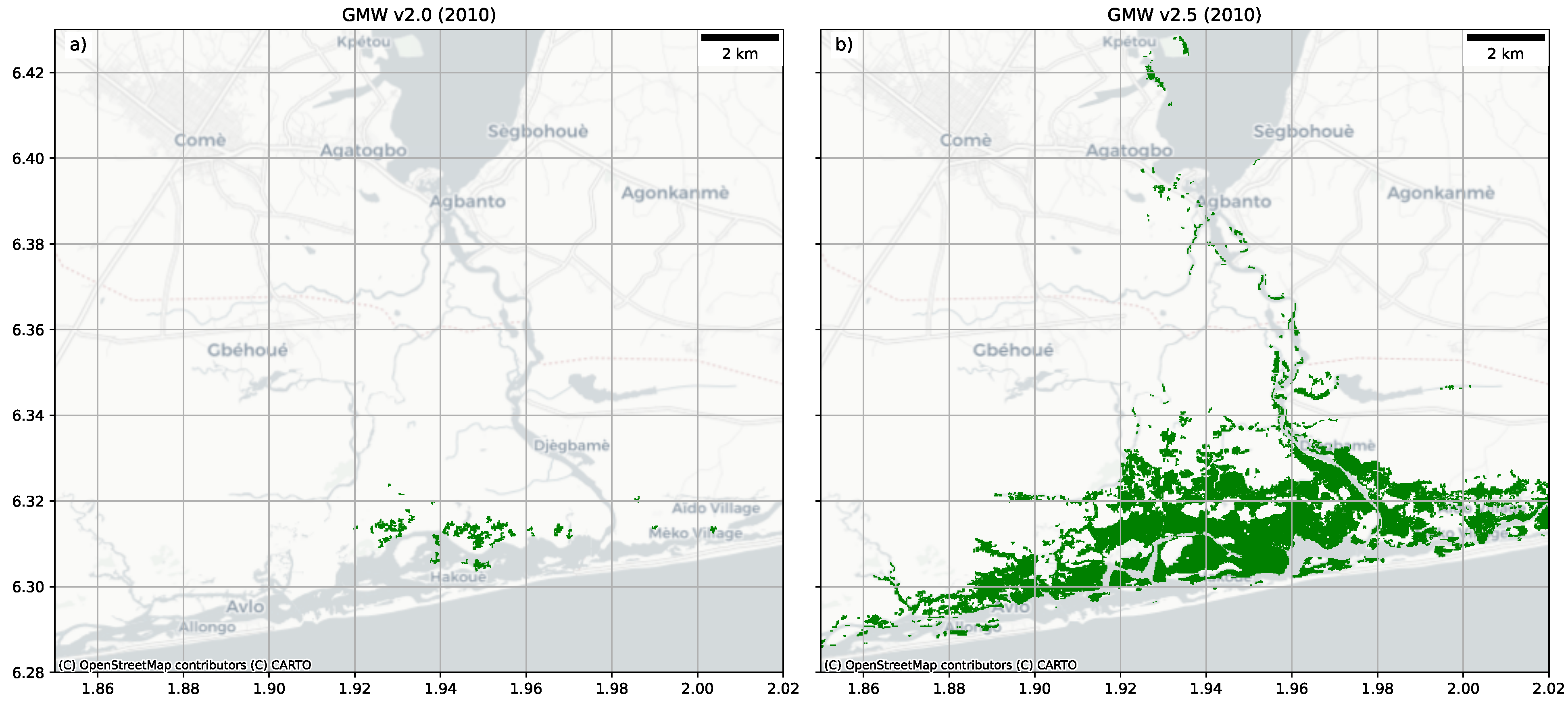
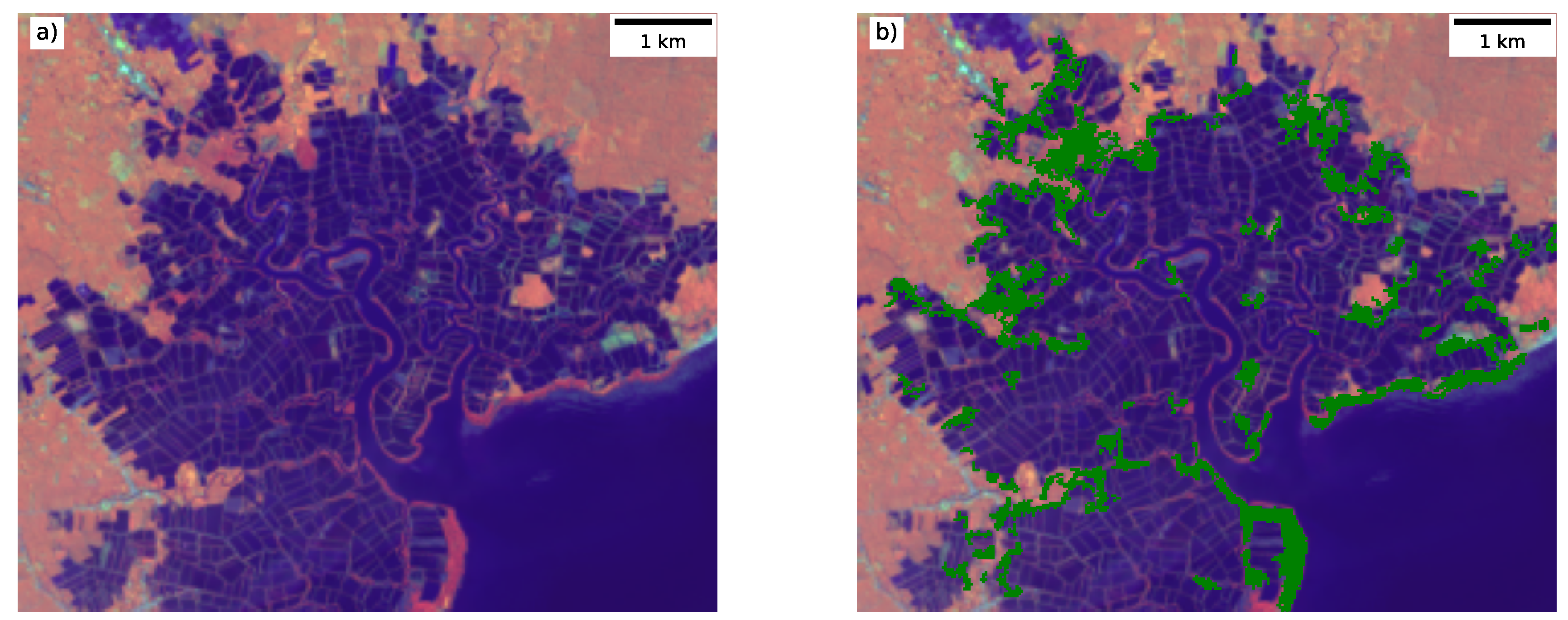
| Parameter | Min. | Low. Quartile | Median | Up. Quartile | Max. | Mode |
|---|---|---|---|---|---|---|
| eta | 0.0835 | 0.236 | 0.299 | 0.299 | 0.489 | 0.299 |
| gamma | 0 | 0 | 0 | 4 | 4 | 0 |
| max_delta_step | 0 | 6 | 7 | 7 | 10 | 7 |
| max_depth | 8 | 13 | 13 | 16 | 20 | 13 |
| min_child_weight | 1 | 10 | 10 | 10 | 10 | 10 |
| num_boost_round | 68 | 100 | 100 | 100 | 100 | 100 |
| subsample | 0.752 | 0.818 | 0.839 | 1.0 | 1.0 | 0.818 |
| Stats (GMW V2.0) | Overall | 95th Confidence | Site Median | Site Min | Site Max |
|---|---|---|---|---|---|
| Overall (%) | 82.6 | 80.1–84.9 | 84.8 | 51.6 | 96.3 |
| Kappa | 0.655 | 0.607–0.698 | 0.734 | 0.393 | 0.927 |
| Macro F1-Score | 0.824 | 0.799–0.847 | 0.866 | 0.334 | 0.963 |
| Mangrove F1-Score | 0.807 | 0.777–0.834 | 0.848 | 0.603 | 0.964 |
| Mangrove Recall | 0.706 | 0.665–0.746 | 0.774 | 0.437 | 0.976 |
| Mangrove Precision | 0.942 | 0.916–0.964 | 0.952 | 0.747 | 0.994 |
| Other F1-Score | 0.841 | 0.817–0.860 | 0.885 | 0.668 | 0.964 |
| Other Recall | 0.953 | 0.934–0.971 | 0.976 | 0.628 | 1.0 |
| Other Precision | 0.752 | 0.717–0.787 | 0.818 | 0.502 | 0.974 |
| Stats (GMW V2.5) | Overall | 95th Confidence | Site Median | Site Min | Site Max |
|---|---|---|---|---|---|
| Overall (%) | 95.0 | 93.7–96.4 | 96.3 | 87.4 | 99.8 |
| Kappa | 0.901 | 0.874–0.928 | 0.926 | 0.748 | 0.995 |
| Macro F1-Score | 0.951 | 0.937–0.964 | 0.963 | 0.872 | 0.997 |
| Mangrove F1-Score | 0.951 | 0.938–0.965 | 0.963 | 0.887 | 0.998 |
| Mangrove Recall | 0.936 | 0.901–0.915 | 0.982 | 0.803 | 1.0 |
| Mangrove Precision | 0.951 | 0.951–0.982 | 0.973 | 0.83 | 1.0 |
| Other F1-Score | 0.950 | 0.935–0.963 | 0.962 | 0.857 | 0.997 |
| Other Recall | 0.966 | 0.949–0.982 | 0.974 | 0.854 | 1.0 |
| Other Precision | 0.934 | 0.911–0.956 | 0.948 | 0.756 | 1.0 |
| Stats (GMW V2.5) | Overall | 95th Confidence | Site Median | Site Min | Site Max |
|---|---|---|---|---|---|
| Overall (%) | 95.1 | 93.8–96.5 | 96.5 | 77.8 | 99.8 |
| Kappa | 0.902 | 0.876–0.930 | 0.930 | 0.556 | 0.995 |
| Macro F1-Score | 0.951 | 0.938–0.965 | 0.964 | 0.768 | 0.997 |
| Mangrove F1-Score | 0.951 | 0.937–0.964 | 0.964 | 0.720 | 0.998 |
| Mangrove Recall | 0.956 | 0.937–0.973 | 0.984 | 0.803 | 1.0 |
| Mangrove Precision | 0.947 | 0.926–0.964 | 0.969 | 0.570 | 1.0 |
| Other F1-Score | 0.952 | 0.938–0.965 | 0.966 | 0.817 | 0.997 |
| Other Recall | 0.947 | 0.923–0.966 | 0.968 | 0.696 | 1.0 |
| Other Precision | 0.956 | 0.938–0.973 | 0.986 | 0.756 | 1.0 |
| Country | GMW v2.5 (ha) 2010 | GMW v2.0 (ha) 2010 | Diff (ha) | Diff (%) |
|---|---|---|---|---|
| Angola | 28,969 | 37,346 | −8377 | −22.4 |
| Australia | 988,842 | 1,006,021 | −17,179 | −1.7 |
| Bahrain | 59 | 82 | −23 | −28.4 |
| Bangladesh | 444,159 | 416,283 | 27,876 | 6.7 |
| Benin | 3390 | 84 | 3307 | 3957.0 |
| Bermuda | 8 | 0 | 8 | − |
| Colombia | 262,212 | 231,187 | 31,025 | 13.4 |
| Fiji | 49,984 | 51,166 | −1182 | −2.3 |
| French Guiana | 59,466 | 50,187 | 9279 | 18.5 |
| Indonesia | 2,801,795 | 2,688,955 | 112,840 | 4.2 |
| Mauritius | 345 | 703 | −357 | −50.9 |
| Mozambique | 298,841 | 301,125 | −2284 | −0.8 |
| Nigeria | 847,894 | 695,775 | 152,119 | 21.9 |
| Papua New Guinea | 445,785 | 476,167 | −30,382 | −6.4 |
| United States | 209,544 | 193,609 | 15,935 | 8.2 |
| Global | 14,025,986 | 13,760,074 | 265,912 | 1.9 |
Publisher’s Note: MDPI stays neutral with regard to jurisdictional claims in published maps and institutional affiliations. |
© 2022 by the authors. Licensee MDPI, Basel, Switzerland. This article is an open access article distributed under the terms and conditions of the Creative Commons Attribution (CC BY) license (https://creativecommons.org/licenses/by/4.0/).
Share and Cite
Bunting, P.; Rosenqvist, A.; Hilarides, L.; Lucas, R.M.; Thomas, N. Global Mangrove Watch: Updated 2010 Mangrove Forest Extent (v2.5). Remote Sens. 2022, 14, 1034. https://doi.org/10.3390/rs14041034
Bunting P, Rosenqvist A, Hilarides L, Lucas RM, Thomas N. Global Mangrove Watch: Updated 2010 Mangrove Forest Extent (v2.5). Remote Sensing. 2022; 14(4):1034. https://doi.org/10.3390/rs14041034
Chicago/Turabian StyleBunting, Pete, Ake Rosenqvist, Lammert Hilarides, Richard M. Lucas, and Nathan Thomas. 2022. "Global Mangrove Watch: Updated 2010 Mangrove Forest Extent (v2.5)" Remote Sensing 14, no. 4: 1034. https://doi.org/10.3390/rs14041034
APA StyleBunting, P., Rosenqvist, A., Hilarides, L., Lucas, R. M., & Thomas, N. (2022). Global Mangrove Watch: Updated 2010 Mangrove Forest Extent (v2.5). Remote Sensing, 14(4), 1034. https://doi.org/10.3390/rs14041034









